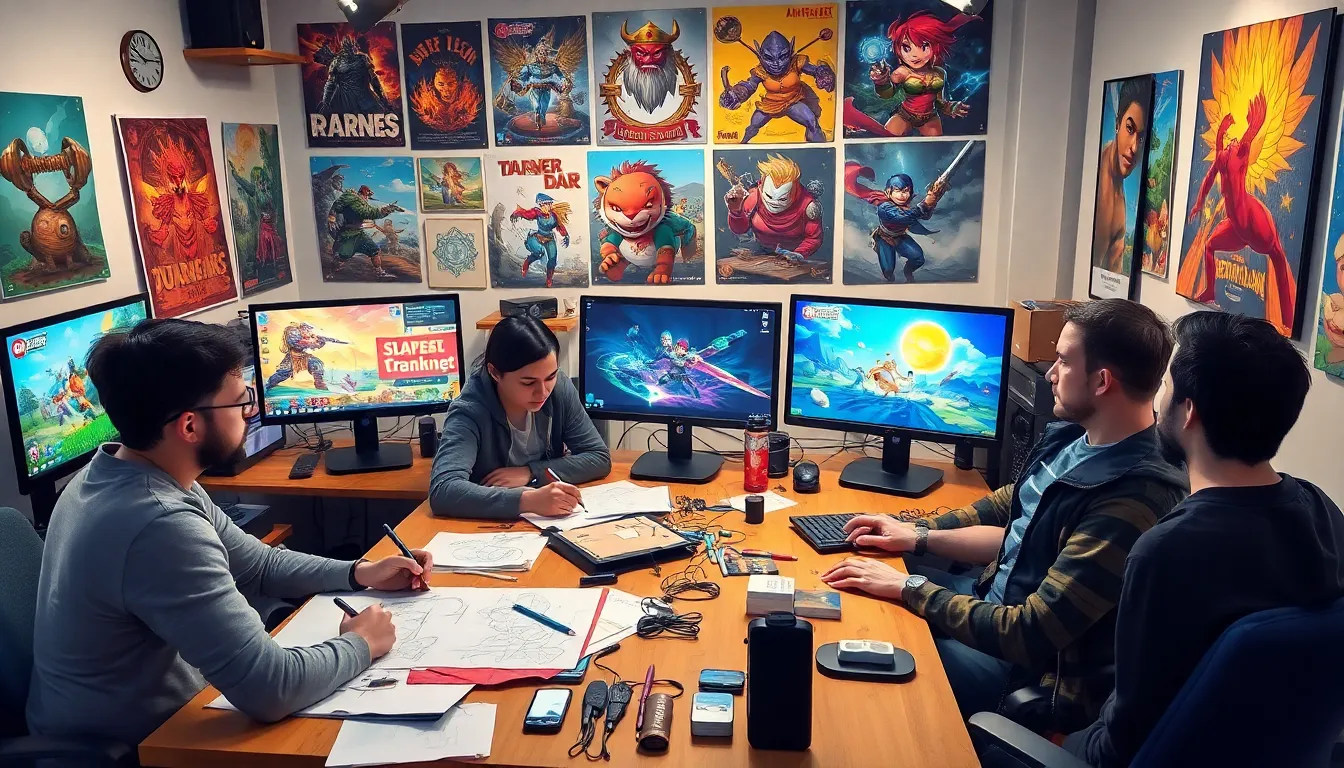Indie games are like the quirky cousins of the gaming world—full of personality, creativity, and just a hint of unpredictability. While mainstream titles often play it safe with big budgets and familiar formulas, indie developers dive headfirst into innovation, crafting unique experiences that can surprise and delight. These games often come from small teams or even solo creators, proving that big ideas don’t always need big wallets.
But what exactly defines an indie game? It’s not just about the budget; it’s about the passion and freedom behind the creation. Indie games often push boundaries, exploring themes and gameplay mechanics that larger studios might shy away from. So, whether you’re a seasoned gamer or just curious about the indie scene, understanding this vibrant corner of the gaming universe can open up a world of unexpected adventures.
Indie Games Definition
Indie games represent a genre that emphasizes creativity and innovation in gaming. These games are typically developed by small teams or individuals, allowing for a unique artistic vision. Enthusiasm drives indie developers, often resulting in unconventional themes and gameplay mechanics that differ significantly from mainstream offerings.
Indie games often pursue ideas outside the constraints of conventional market demands. Without large budgets, creators prioritize storytelling, art style, and experimental gameplay. This freedom fosters diverse experiences that can engage players in ways more traditional games may not.
Many indie titles explore themes of identity, mental health, and social issues, which resonate deeply with audiences. The narrative depth frequently found in these games creates connections that enhance player engagement. Unique art styles also contribute to their charm, distinguishing them from commercial titles.
Several notable indie games, like “Hollow Knight” and “Celeste,” demonstrate the success of this genre. Each of these games received critical acclaim and a dedicated following, showcasing the impact indie games can have on the industry. These examples illustrate how passion-driven development can lead to both innovation and commercial success.
Indie games define a vibrant sector within the gaming landscape. They prioritize creativity, uniqueness, and storytelling, providing players with fresh and memorable experiences.
Characteristics of Indie Games

Indie games exhibit distinct features that set them apart from mainstream titles. These characteristics contribute to their unique appeal in the gaming landscape.
Creative Freedom
Indie developers enjoy significant creative freedom, allowing them to explore unconventional ideas. They often challenge typical gaming norms, focusing on innovative narratives and gameplay mechanics. Experimentation remains a hallmark of indie games, as creators express their artistic visions without the constraints of large publishers. Such independence encourages diverse storytelling, reflecting personal experiences and societal issues. This environment fosters unique player experiences, where engagement emerges from the depth of exploration and connection to themes like identity and mental health.
Unique Art Styles
Unique art styles define many indie games, showcasing a wide range of artistic expression. Developers frequently use hand-drawn graphics, pixel art, or abstract designs to create visual experiences that resonate with players. This diversity in art enhances the overall narrative, allowing deeper emotional connections. Distinctive visuals often correspond to gameplay mechanics, enriching player immersion. Titles like “Journey” and “Gris” exemplify how art can elevate the gaming experience, drawing players into imaginative worlds that reflect their creative intentions.
The Evolution of Indie Games
Indie games have undergone significant transformations, gaining prominence and recognition over the years. These changes reflect the shifting landscape of gaming.
Early Beginnings
Independent game development began in the late 1970s to early 1980s, when a handful of developers created games outside traditional publishing structures. Garage developers and hobbyists often produced titles without the backing of major studios. This early era saw the release of games like “Zork” and “Adventure,” which laid the foundation for indie game culture. Creative freedom defined this period, as developers explored unique concepts and narratives. The emergence of home computers further facilitated this movement, allowing creators to share their work with niche audiences.
The Rise of Digital Distribution
Digital distribution revolutionized the indie game sector in the 2000s by providing direct access to consumers. Platforms like Steam and Xbox Live enabled developers to publish games without relying on physical retail channels. By removing barriers to entry, these platforms allowed indie games to flourish. Notable successes from this era, such as “Braid” and “Super Meat Boy,” highlighted the potential for indie developers to reach wider audiences. Gamers embraced this shift, leading to increased demand for innovative titles. This transformation solidified indie games as a vital component within the gaming industry.
Notable Indie Games
Indie games have gained recognition for their unique contributions to the gaming landscape. They serve as a testament to the creativity and innovation stemming from smaller development teams.
Game Examples
“Undertale” captivates players with its innovative mechanics and emotional narrative. “Hollow Knight” showcases stunning hand-drawn visuals paired with challenging gameplay. “Celeste” delivers a heartfelt story about overcoming personal struggles through platforming. “Stardew Valley” invites players to embrace life on a farm, allowing for customization and exploration. “Hades” merges roguelike gameplay with rich storytelling, redefining genre standards. Each of these titles exemplifies the diversity found within indie game development.
Impact on the Gaming Industry
Indie games transformed the industry by introducing innovative gameplay mechanics that challenge mainstream conventions. They helped revive interest in gaming by showcasing unique narratives and artistic visions through platforms like Steam and itch.io. Success stories like “Braid” and “Super Meat Boy” inspired many aspiring developers to pursue their creative passions. The increasing availability of development tools democratized game creation, empowering a broader range of voices in the industry. Consequently, indie games not only enriched the player experience but also reshaped perceptions of what video games can achieve.
The Future of Indie Games
Future developments in indie games promise increased innovation and creativity. Developers continue to explore emerging technologies like virtual reality and augmented reality, creating new gameplay experiences. These advancements allow for more immersive interactions, enabling players to engage deeply with narratives and worlds.
Indie studios are likely to focus on community-driven development, involving players in the creative process. Using platforms such as Kickstarter, developers secure funding and gather community feedback, ensuring their games align with player interests. This collaborative approach not only enhances player loyalty but also allows developers to refine their visions based on real-time insights.
Diversity in game themes will play a crucial role in the future landscape of indie games. As societal issues gain prominence, developers increasingly address topics like mental health, identity, and sustainability, resonating with a broader audience. Narrative depth remains a priority, as players seek not only entertainment but also meaningful connections through storytelling.
Emerging trends indicate that cross-platform accessibility will become standard practice among indie developers. Ensuring that games are available on multiple devices fosters a wider reach and enhances player engagement. Developers recognize that accessibility enhances the gaming community and invites diverse audiences to experience their creations.
Lastly, the continuation of indie game festivals and showcases will further elevate the visibility of indie titles. Events that highlight innovative independent projects allow developers to connect with players, industry professionals, and potential investors. These opportunities ensure that indie games maintain a prominent role in the evolving gaming ecosystem, celebrating creativity and passion in their development.
Conclusion
Indie games embody the spirit of creativity and innovation in the gaming world. With their focus on unique narratives and artistic expression, these titles continue to captivate players and redefine expectations. The evolution of indie games reflects a growing appreciation for diverse voices and experiences within the industry.
As technology advances and community engagement increases, the future of indie gaming looks promising. Developers are poised to explore new frontiers in gameplay and storytelling, ensuring that indie games remain a vital and exciting part of the gaming landscape. The passion and dedication behind each title resonate deeply, inviting players to embark on unforgettable journeys.




